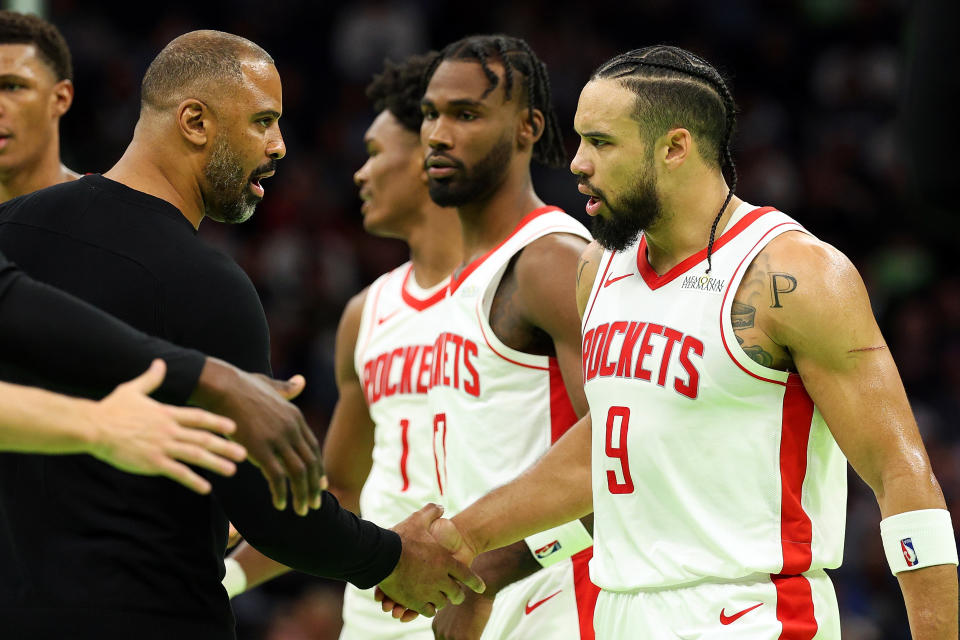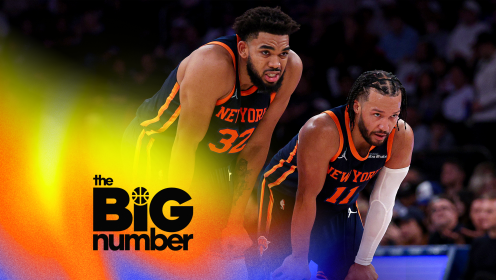
The Rockets’ attempt to become a serious outfit began in earnest last season on the defensive end. It’s no shock that their attempt to take the next step this season — from serious to scary, from also-ran to contender — has started there, too.
“Every team that’s won a championship is usually a top-five ranked defense,” Rockets head coach Ime Udoka recently told Michael Pina of The Ringer. “That’s a non-negotiable for me.”
Building a top-flight defense — which Udoka and Co. have done, as Houston enters Thursday’s matchup with the Warriors ranked second in defensive efficiency, according to Cleaning the Glass — establishes a high floor. In the age of pace, space and unfettered 3-point bombing, though, it’s the other end of the court that often determines a team’s ceiling.
Twenty of the last 21 NBA champions featured a top-10 offense. The one that didn’t, the 2021-22 Warriors, had Stephen Curry … which, y’know, is basically the same thing. Those Dubs also scored 116.4 points per 100 possessions outside of garbage time in the playoffs; that would’ve been the second-best offense in the league during the regular season.
These Rockets aren’t built around a single megawatt offensive force on the order of Curry, Giannis Antetokounmpo, a healthy Kawhi Leonard or Nikola Jokić. They’re not built around an armada of shooters like the Celtics team that Udoka used to coach, or an overwhelming tandem like the LeBron James/Anthony Davis duo that led the Lakers to the 2020 title. Fourth-year center Alperen Şengün provides about as compelling a Joker impersonation as there is in the game, but he’s seen his shooting efficiency decline both inside and outside the arc. After five straight 20-plus-point performances to open the season, former No. 2 overall pick Jalen Green has once again waned, shooting a career-worst 47% on 2-pointers and 33.1% on 3s with a barely positive assist-to-turnover ratio. Fred VanVleet remains a rock-solid table-setter, but he’s missing more than two-thirds of his triples.
Houston’s off to a fantastic start at 15-7, a game and a half out of first place in the Western Conference. But that lack of firepower could wind up being the contender-or-pretender dividing line for Udoka’s club, which ranks 26th in team field-goal percentage and 3-point percentage, dead last in assist rate and just ninth in offensive efficiency.
… Wait a second. What?
That’s right: Despite having only one rotation player shooting 50% from the field (Amen Thompson) and one rotation player shooting above league-average from 3-point land (Dillon Brooks), and despite sitting in the bottom four in both effective field-goal percentage (which accounts for 3-pointers being worth more than 2-pointers) and true shooting percentage (which factors in 2-point, 3-point and free-throw accuracy), Houston is scoring 115.1 points per 100 possessions outside of garbage time this season — which is tied with the resurgent Bucks for ninth in offense, according to Cleaning the Glass.
Which, given those shooting numbers, raises a question: Um, how?
The first step to building a top-tier offense without top-tier shooting, it turns out: relying on your top-tier defense.
Led by All-Defensive teamer Brooks and newly dubbed “Terror Twins” Thompson and Tari Eason, the Rockets’ rotation overflows with long-armed, athletic, mean-spirited and magnet-handed wings. They don’t just get stops; they rupture offensive trips, ranking seventh in blocks, 10th in steals, 11th in deflections and 12th in opponent turnover rate. They also prioritize putting periods at the end of their defensive possessions, ranking 10th in defensive rebounding rate.
And once they’ve got the ball back, the Rockets launch:
[embedded content]
Houston scores just 92 points per 100 possessions in half-court settings — 25th in the NBA. Out in transition, though, when you’re either ahead of the defense or have it backpedaling and unsettled? That rises to 127.6 points-per-100 — and 140.3 points-per-100 after a steal. When you’ve got a way to boost your offense from terrible to awesome, it’s a good idea to do it as often as possible; in a related story, only four teams attack in transition more frequently than Udoka’s Rockets, and only Denver scores more fast-break points per game.
Even when you prioritize pushing the pace, though, you’re still going to spend at least three-quarters of your offensive possessions playing in the half-court, against set defenses — which, as we just noted, is not exactly the forte of a Rockets offense that struggles to shoot straight. A good second step to building that top-tier offense, then: getting lots and lots of shots up.
Houston leads the NBA in field-goal attempts per game, thanks partly to elite turnover avoidance — after finishing dead last in turnover rate in the two seasons before Fred VanVleet showed up, they’ve ranked sixth and fourth since the sure-handed lead guard’s arrival — and partly to absolutely ravenous marauding of the offensive glass:
[embedded content]
All of Houston’s centers — Şengün, Steven Adams and Jock Landale — can either root themselves in front of the rim or bulldoze would-be box-out artists under it to get their preferred position. All of Houston’s tarantula-armed, quick-twitch forwards and swingmen — Thompson, Eason, Jabari Smith Jr., Cam Whitmore, et al. — have the quickness to slice in between opponents in the paint, the hops to go get the ball over the top of them, and the instincts to follow the shot, whether their own or someone else’s.
While some coaches would look to tamp down that aggressiveness in favor of sending everyone sprinting back to prevent fast-break baskets, Udoka has instructed his charges to relentlessly pursue misses. The logic is twofold. For one thing, making it harder for opponents to get the ball makes it harder for them to punish you with it. (“We felt you could crash at a high rate, and it’s almost the first layer of your transition defense,” Udoka told Pina.)
For another: the reward of getting another bite at the apple far outweighs the risk. The Rockets have gobbled up 34.5% of available offensive rebounds this season, tops in the NBA, and turned those do-overs into 17.7 second-chance points per game, second behind only the Hornets. Houston’s scoring 106.6 points-per-100 on putbacks, which is nearly 15 points-per-100 above its overall half-court offensive rating, and a major boost to the bottom line for a team that needs to make its magic in the scoring margins.
Three Rockets rank in the top 25 in the NBA in offensive rebounding rate: Şengün and the Terror Twins, the 6-foot-8 Eason and 6-foot-7 Thompson, who hurl themselves at the backboard at speeds and angles inaccessible to most other humans. That trio has played only 146 minutes together this season; in them, Houston has hauled in an absurd 38.4% of its misses.
Eason’s production this season deserves a brief sidebar. After missing most of last season with a growth on his left shin bone, the 23-year-old forward is putting up jaw-dropping per-minute numbers off Houston’s bench: 17.8 points, 10.1 rebounds, 3.3 steals, 1.7 assists and 1.6 blocks per 36 minutes of work. The third-year pro is grabbing offensive rebounds on more than 10% of Houston’s possessions and coming away with blocks and steals on more than 3% of Houston’s opponents’ possessions. Only two other dudes in NBA history have done that … and they’re Hakeem Olajuwon and David Robinson.
That team-wide relentlessness and commitment to hammering the basket — Houston’s seventh in the share of its shots that come directly at the rim — has another downstream benefit: The Rockets generate a lot of whistles.
Only the Magic, Grizzlies and Nuggets draw more fouls per game than Houston, with bull-in-a-china-shop Şengün leading the pack at 5.5 per game — tied with Kevin Durant for eighth in the NBA among players who’ve made at least 10 appearances — and only the Nuggets attempt more free throws per contest. Only the Magic and Nuggets spend a higher share of their offensive possessions in the bonus than Houston.
This is important because, as Owen Phillips recently noted in The F5, “On average, getting into the bonus is worth about two points of offensive rating.” This season, that’s about the difference between being a top-10 offense and a bottom-10 offense — which is a very big difference, especially for a team with very big plans.
“The goal is to go deep,” VanVleet recently told Kelly Iko of The Athletic. “And not just to make the playoffs — making a real run.”
A real run will require real offensive creativity and cohesion: the resourcefulness to find multiple pathways to points when the game slows down and stresses out, the craft to generate good looks against the best defenses, and the skill to knock them down. Whether these Rockets can develop that — whether this top-10 offense is solid or smoke — is one of the most interesting questions in the NBA right now.
You can get a long way by beating the crap out of people on the offensive glass, taking care of the ball, forcing turnovers and getting out in transition. Going all the way, though, demands more.

